Text
THIS IS obviously going to be a eternal WIP bUT here is now my current WorldAnvil for Aanrah! I plink at it periodically as my hyperfixation allows but hey-
2 notes
·
View notes
Text

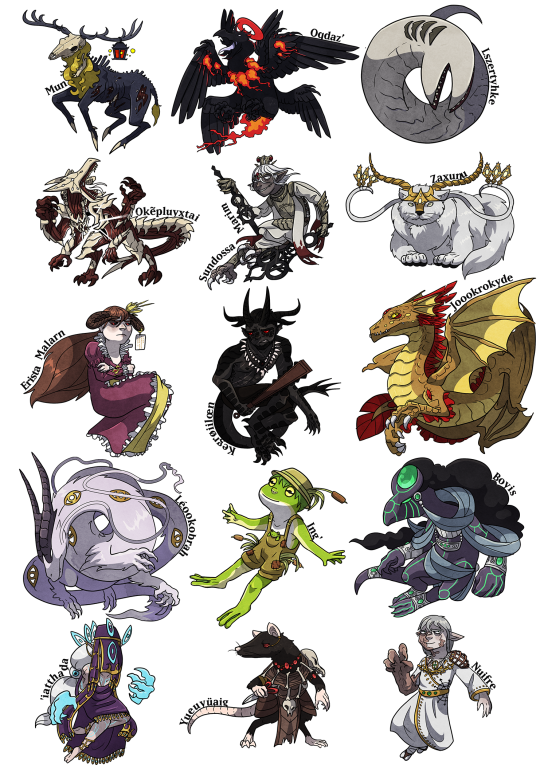
Two more little character sheets I forgot to upload awhile ago. Mostly gods, though the first sheet's third, fourth, and fifth row aren't. Or aren't really - Iuin & Zhün are demigods technically and Ua is maybe a deity maybe not.
#homebrew#ttrpg#dnd#dungeons and dragons#worldbuilding#tabletop#deity#oc#fantasy#Eu#The Night Hunt#Cruomfiege#Quede#Ceatth#Uzuenshai Ueltohuon#Meekhuhtahqn#Soru#Heliocene#Thaliadine#Ahndiirnliilul#Zhun the Exiled#Iuin of Clan Lan#Ua Oeru#Veross the Pyre-Hearted#Mun#Oqdaz'#Lszertyhke#Okepluyxtai#Sundossa Marim#Zaxunu
10 notes
·
View notes
Text

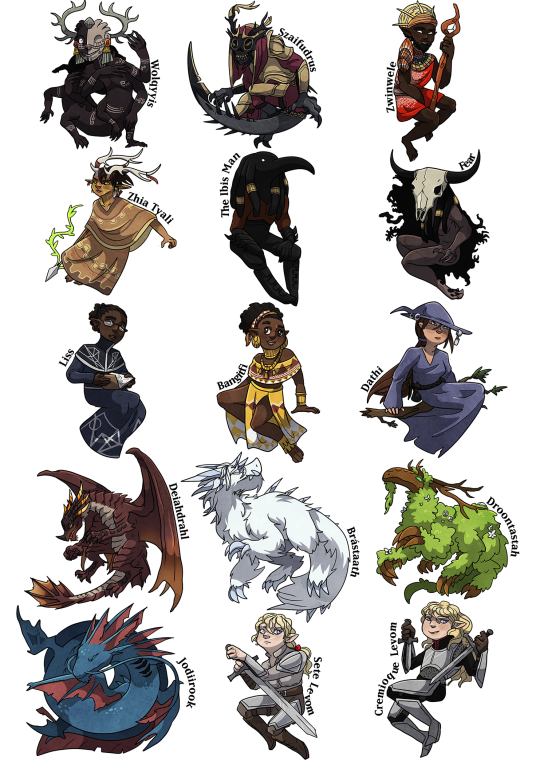
A bunch of kinda chibis for possible meme purposes and also just quick design things. All of them here are gods! So many names to tag...
#worlduilding#deity#gods#homebrew#ttrpg#dnd#dungeons and dragons#tabletop#oc#fantasy#dragon#dark elf#merfolk#elves#monster#oreik#sen srrgrrlus#brobh boig#talatarael#ort#maholdymyndr#baghann#artitengh#khtoth#ciurte#norve#emrul#eiylsweir#evermore#yalidil rana
19 notes
·
View notes
Text
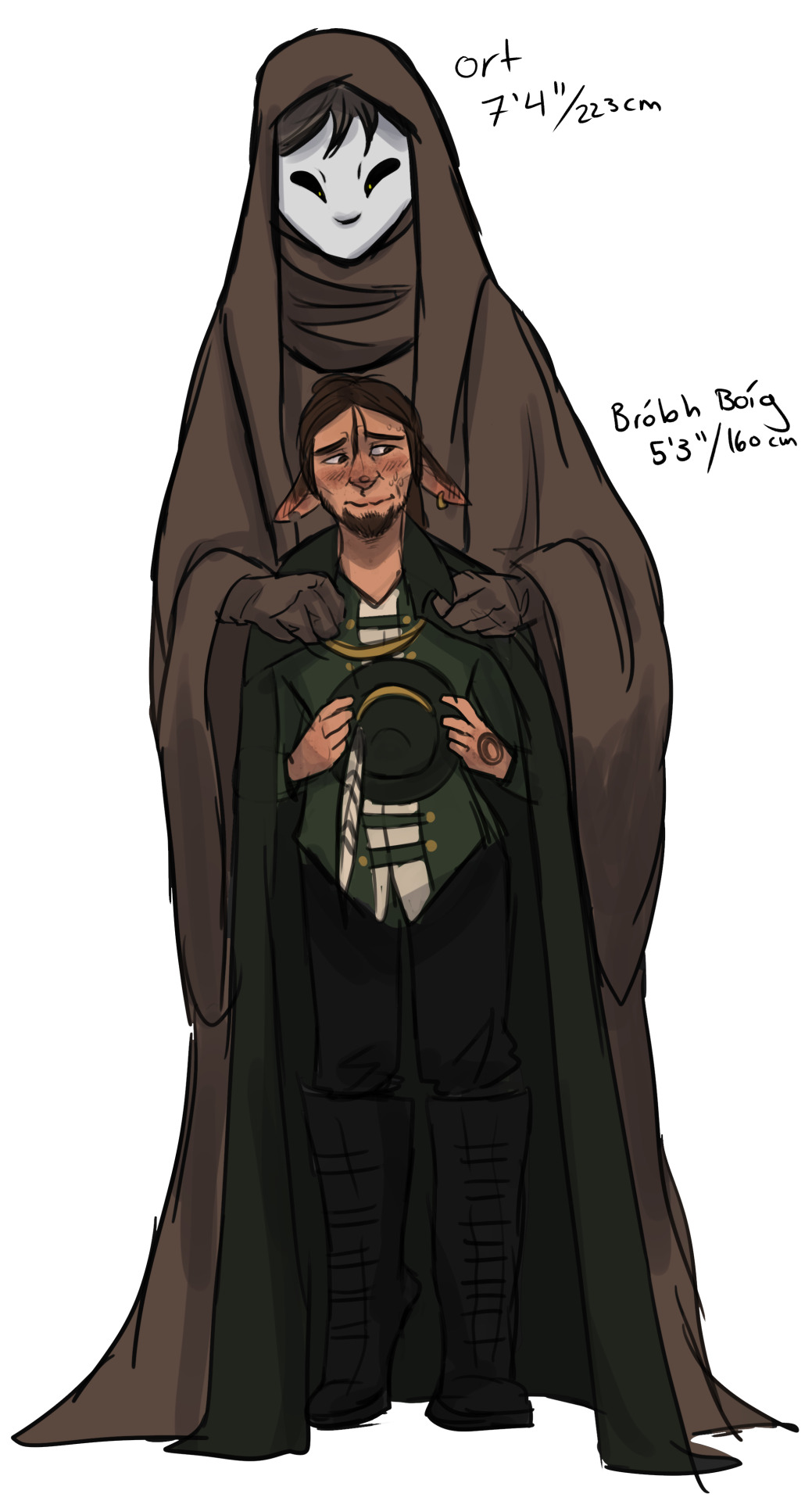
Also realizing I accidentally made Bróbh Boíg an Ort have a ridiculous height difference. When ur husband is a whole ass 2+ feet taller than you...
0 notes
Text

More deities! (And also Ort again because I fixed his textures).
From top left to lower right...
Ineyale Phor, the Yuenhüuian God of of the moon Baza
Mgachyt', the Outsider God of Stars & Astronomy
Mglw'nochyt', the Outsider God of Infinity
Baghánn, the Nuríian God of Jesters & Trickery
Ort, the Nuríian God of Woodlands, Forests, & the Lost
Oqdaz', the Lakrakian God of Lightning, Storms, & Strength
Zhia Tyali, the Náian God of Nature, Plants, & Wood Elves
Aðrrakroo, the Drylvuian God of Fish & Lakes
Ing', the Weg'olw'chyen God of Ponds, Rivers, & Frogs
#homebrew#ttrpg#dnd#dungeons and dragons#worldbuilding#tabletop#oc#ray art#deities#deity#fantasy#ineyale phor#magchyt#mglwnochyt#baghann#ort#oqdaz#zhia tyali#adrrakroo#ing
10 notes
·
View notes
Text
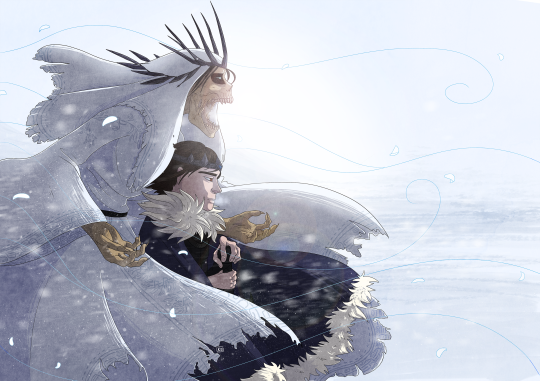
Young King Heliocene and Ahundiirnliilul, the lich his sister Thaliadine released to mentor and basically babysit him. At 12, Heliocene has a lot riding on his shoulders and already more enemies then he can count, so he needs all the help he can get...
#ttrpg#homebrew#worlduilding#lich#undead#oc#oc art#original characters#dnd#dungeons and dragons#Heliocene#Ahundiirnliilul#Ray's art
5 notes
·
View notes
Text
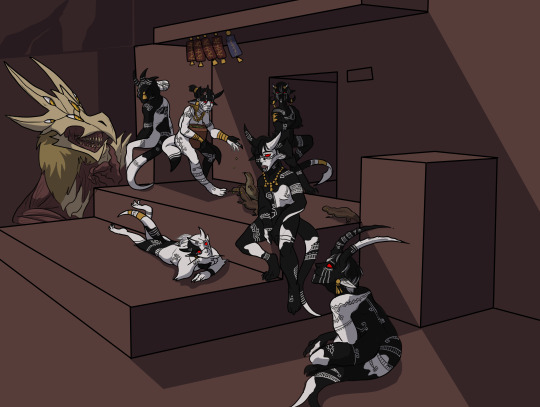
A normal Nymauti demon apartment front, with lazy building that I didn't proportion right.
2 notes
·
View notes
Text

The Revenant is the only one in Aanrah with a gun, so the first time he teamed up with the hero gods, neither the heroes nor the villains of Oreik or Uzuenshai were expecting it.
#gun#ttrpg#doodle#comic#worlduilding#oreik#Uzuenshai#the revenant#dag-mountain-breaker#tme'tzem#ray art
2 notes
·
View notes
Text

Haven't been drawing people as much so trying to get back into it. Using some of the poses from over at @grey-fuckers-unlimited to help me get back into shape.
#worlduilding#dark elf#dragon#harpy#demon#oreik#maholdymyndr#ukoi-dhejaha#reen#dain#homebrew#ttrpg#dungeons and dragons#tabletop#ray art
19 notes
·
View notes
Text
Reworking on World Anvil, remade my page cuz I changed a bunch, putting in deity baseline heights while I put in coding scaffolding, realize I made Bróbh Boíg, by merit of being a wood elf, >5'5", while like... all his male paramours are like. Over. 7' because of their races...
0 notes
Text
Also the itch to re-do language things that would require so. So. So much renaming and work.
#told myself not to make more species-based languages cuz let's be honest it doesn't totallyw ork like that and I did anyways and now#its kind abugging me. shrieks#ray blabs
0 notes
Text
Me: You have too many deities-
Also Me: Okay but there could be multiple gods of X thing just across different pantheons-
Me: nO WE ALREADY HAVE A LOT-
0 notes
Text
On Dragons
Created as a sort of divine byproduct of the world’s creation, dragons are (or were) one of the most diverse races on Aanrah. Dragons are capable of coming in a vast variety of shapes, colors, and sizes. Dragons have four limbs at minimum and eight at maximum, in any combination of wings, arms, and legs. They are capable of living in any climate or terrain, and their inherent magic or ‘breath weapon’ is some of the most variable of any species. Dragons come in a variety of sizes, with size being a direct indicator of age - dragons do not stop growing*, so the largest dragons are usually the oldest. Dragons are capable of assuming a humanoid form, which often appears as a bipedal version of their dragon forms with similar (but not always exact) number of limbs.
Dragons can lay up to 6 eggs, which will take six to eight months to hatch if incubated properly. Incubation consistency and relative temperature can have a impact on offspring sex. Dragons consider themselves to have five possible sexes - drake, drake-lead, true lead, hen-lead, and hen. Those on the drake end of the scale are capable of fertilizing eggs, and those on the hen end of the scale can lay eggs - with leads being steps between (with true lead capable of both). Eggs who experience consistent incubation at properly warm temperatures are more likely to hatch drakes - with eggs who experience consistently cool temperatures more likely to produce hens. Eggs who experience fluctuation may undergo a shift in what sex they’re developing as, often leading to leads. That said, it’s not a guarantee, and it’s always possible to have a clutch of 6 eggs kept constantly warm to hatch as all true leads, or a violently fluctuating nest kept usually cold to hatch as just drakes. As a result, dragons have a much looser concept of ‘gender’ than most races, with sex and gender being a vastly sliding scale with a large portion of the population at various levels of in-between. Dragons are also capable of changing sex, capable of shifting one ‘step’ in the ‘scale’ in about a decade. It’s possible for a dragon to be born a drake and shift fully to being a hen, with no ability to indicate it had ever been born otherwise.
Dragons can live to a average of 800 (world events aside), with dragons reach their juvenile age at 50 years, their adult age at 100, and considered being old at 500. Young dragons before their adulthood had a high mortality rate before the 10th Era - being much weaker and much more foolish - but since the 10th Era the whole of dragonkind at any life stage has a high mortality rate. Since the 10th Era, full-blooded dragons are largely considered to be extinct - while there are confirmed to be a few still around, and thought to likely be more, their numbers have dwindled terribly and they are no longer the threat they once were. Dragons who survive to start to reach their older years are capable of becoming immortal and becoming sort of ‘pseudo-gods’ - becoming incapable of dying to anything but being slain.
(Cont. under the cut)
Ancient dragons, as they’re often called, undergo a process in which they are capable of honing their inherent or ‘divine’ capabilities, usually finding themselves focused on something in particular that will become their new source of power. Through this, they become largely impervious to what would otherwise kill them - illness, disease, suffocation, dehydration, and starvation are some of the forms of death ancient dragons find themselves able to stave off. While still capable of being slain, they become much harder to kill than a non-’ancient’ dragon of the same size and age. The trade off becomes that in order to fuel their inherent powers and ability to grow, they must consume their new source object - which can be anything from a physical object (such as gold, coal, raw meat, or magic items) to a concept (knowledge itself, suffering, fear). The amount of energy gained is usually relative to the relative quantity of the item in the world, the quality of the thing, and the difficulty of obtaining it. As such, raw meat requires much more consumption than magic objects to equate the same amount of energy, for example. This also becomes the exception * for above - dragons who are not consuming their source will not die, but will grow weak, unable to use their breath weapon or magic, and will not continue growing. While not actually gods, ancient dragons will find themselves often more driven by their source and focus in a way similar to gods and their domains, as their inherent magic and source of self becomes tilted towards it.
Dragons are capable of interbreeding with anything. Half-dragons only appear as their other parent’s base form, with the addition of draconic traits of their draconic parent (horns, tinted base skin/fur/feather color, scales, claws, tail, wings if applicable, etc.) They are capable of using the same breath weapon and similar magic of their draconic parent, and are subject to the same conditions of temperature and its influence on their sex. Similarly, half-dragons are capable of changing their sex, just much more slowly. It’s rare for a half-dragon to live long enough to fully swing from one side of the scale to the other, but it would not be unheard of for a drake to make it to being some ‘level’ of hen-lead. Quarter dragons usually spout only small patches of scales and horns and some of their ancestor’s magic ‘flavor’. Draconic descendants are known for their magical prowess and continued inherent magic capabilities well after any other signs of dragon ancestry are gone. Female members of species who reproduce with dragons will lay eggs, and those who do not already lay eggs naturally usually have between one and three eggs. These eggs are much smaller than what would come from a dragon, resulting often in relatively small hatchlings in comparison to a normal baby of the mother species.
Dragons were once a proud and prosperous race who controlled large swaths of territory and demanded respect and power. Prior to the 10th Era, dragons who made it into their adulthood were incredibly difficult to slay, and the older they got the more impossible they were to get rid of - even by large groups and well-trained fighters. As a result, dragons usually served as ‘secondary’ rulers to many kingdoms, demanding tribute but not necessarily being a part of the political process (whatever it may be). Other dragons cut swaths of land into their own countries, ruling as tyrants. Dragons did not commonly live in with other races or in cities, usually forging their own communities or living alone.
Not all dragons were (or are) malicious or aggressive, though they are always thought to be. Even genuinely well-meaning and friendly dragons are giving a air of caution and distrust, and treated with the knowledge that a bad day could leave a city ablaze. That said, thanks to dragons natural capacity to interbreed with anything, dragons are equally notorious for mingling where they are welcome. It is thought that in addition to the obvious genocide on dragon kind after the 10th Era, the fact that many remaining or not immediately slain dragons were often mingling with non-dragons and producing only half-dragons had a rough hit to the population of pure dragons.
Since the 10th Era, only half-dragons largely remain. While half-dragons are not uncommon, they are still looked at unfavorably, and often considered dangerous civilians in many countries. In many places, it is legal to slay anyone with more than 1/2 dragon ancestry, or anyone with dragon ancestry and ancestry of any other ‘non-standard’ race (such as Nymauti demons, sphinxes, or fae). The countries of Tafthaag and the Kingdom of Klolvahhés in the mountainous heart of the continent Vuorlan are the only places that would allow a full dragon to take its true form and offer it full legal protection.
11 notes
·
View notes
Text
On Nymauti Demons
Nymauti demons are a race considered ‘interlopers’ - originating from somewhere outside of Aanrah. They are tied to a system that exists beyond this world, and beyond even Talatarael’s control.
Nymauti demon appear as humanoids with white and black skin, commonly sporting some flavor of horns and a tail. Asymmetry is common and expected - this usually comes in the form of missing eyes, asymmetrical horns or tail(s), and patterning- but asymmetrical or missing limbs are not uncommon either. Their skin is covered in intricate patterns that are the most commonly passed trait to species of mixed Nymauti ancestry. Nymauti demons have a average lifespan of about 600 years, reaching their juvenile stage around 15, adulthood at 40, and are considered old around 400. Nymauti have anywhere between one to three offspring, with twins being very, very common.
A important aspect of Nymauti, both biologically and culturally, is their Name. At birth, Nymauti are Nameless - and subject to the ability to be summoned at random. Often called ‘imps’ by summoners, Nymauti under the age of 15 are often considered in a ‘larval’ stage and due to their lack of Name, are easily pulled by the forces of weak summoning spells. Summoned imp Nymauti become trapped in their ‘larval’ stage, even if they are miraculously every returned from being summoned. The forces at play in summoning and their Names is beyond the control of even Talatarael - it is something tied to even her, and existed before she was born. Most summoned Nymauti are pulled to other dimensions beyond Aanrah, though anyone summoning demons on Aanrah will be drawing from the same pool.
As a result, adolescent Nymauti have a incredibly high mortality rate. Less then 50% of adolescent Nymauti will reach their Ceremony of Naming at 15. As a result, Nymauti demons commonly raise their young as a large community, and are incredibly dethatched from their young. Offspring are rarely given names or labels, and names prior to their Ceremony of Naming usually come from fellow adolescents. Their first 15 years are tense and stressful for both children and their community group - adolescent demons will vanish with no warning, never to return. For the fleetingly few that ever are to return, it’s often years to decades later - these Imps are are forever changed to a sort of eternal immaturity, and are likely to be summoned again as they will never develop a Name properly.
(Cont under the cut)
Those who do reach the age of 15 are given a Ceremony of Naming, in which they are taken by the elders of their community and Named. More specifically, this ceremony helps the subject understand and confirm their True Name, and gives them a nickname in which the community will call them. This nickname is often a noun or descriptor that relates to them.
Their Name, however, can be thought of as a sort of program code. It is compromised of Nymauti words and occasional nonsense filler that essentially directs what would be considered divine magic in other beings. This string of words both specifies what magic the demon inherently has, as well as is a unique identifier that would allow them to be summoned directly if discovered. As a result, no two Nymauti ever have the same name at the same time, but a name can be ‘reassigned’ if the previous owner is deceased - or, more commonly, the previous owner’s name gains new words.
As a Nymauti ages, they are capable of preforming meditation and rituals to essentially ‘extend’ their name - adding more ‘lines of code’ that both makes them more powerful, capable of more skills and magic, and more difficult to summon. It is a task that requires the demon to be strong enough to take on the magic changes needed, and to understand what they’re adding. It is this process that allowed the lesser god Wolqyyis to become a demon and ascend, and that he studies closely. The most powerful demons have ridiculously long names that describe a long list of magic they are able to preform at will inherently, and the wisest and most skilled demons often have packed what could be considered ‘filler’ or ‘nonsense’ words in to help make discovering their Name and summoning them incredibly difficult. Talatarael is assumed to have the longest name, with Wolqyyis knowing what is thought to be a fair chunk of it (as told by Talatarael, in a Deal between the two regarding his continued existence and his research).
Demon summoners in the world of Aanrah are, rather fairly, considered rather amoral for summoning Nymauti demons. Most countries consider it a form of enslavement, since they are sentient individuals who are being taken from a very visit-able location. The most prolific demon summoning circles keep records recording the most ‘common’ Nymauti names - usually names given to young just-Named Nymauti that are known to actually be used. So even as adults, Nymauti are not safe from being summoned. Knowing a Nymauti demon’s Name gives that person the ability for complete control, as they know what is essentially the words that make up the foundation for its very being. As such, Nymauti guard it aggressively, even from their most trusted friends.
A vast majority of Nymauti demons live in the Underworld - the plane of reality that lays just on top of Aanrah’s, and is easily reached in the deepest parts of the Underground. They live most often in large cavernous cities, packed tightly together in close-knit groups. Underworld Nymauti are very community-based, having only a loose concept of ownership. Most resources are shared, and usually trading and purchases happen on a community level instead of a individual one. Communities consist often of a large group of households that have designated ‘common grounds’ and then usually more private individual lodging for beds and the likes. Work is split up among the individuals, from cooking to cleaning to child watching. A family is simply considered the community - marriage and monogamy is a foreign subject to them, and often the only concerns and tracking for offspring’s parents is to prevent inbreeding. Underworld Nymauti usually forego clothing, but are known for wearing a lot of jewelry or light-weight and loose articles like scarfs or sashes. Through the Underworld, Nymauti (or anyone else) is capable of reaching other planes - as a result, there is a thriving network and market of otherworldly items and materials that come through the Underworld’s market spaces. There are several prolific Nymauti communities who’s entire business is undertaking expeditions to find things from outside worlds to peddle in Aanrah and Aanrah Underworld communities.
The Underground also sports a fair population of Nymauti, though still a fraction of the population as a whole. They are found more densely the closer to the Underworld one goes, and their population almost vanishes just before getting to the more surface levels. Nymauti who live outside of the Underworld either live in very closed, tight-knit communities who practice more Underworld Nymauti lifestyles, or have aggressively integrated themselves into the local culture and population. In the underworld, Nymauti are not considered particularly unusual, and most countries treat them no differently than any other race.
On the surface, Nymauti are exceedingly rare. Outside of the country of Cyhqn Tanye (a Nymauti democracy located in a desert region on the continent of Tshasir’s eastern seaboard) and the country of Lányc Grala (a country ruled by Wolqyyis in the tropics of the south western seaboard of the continent of Cryngasth), Nymauti are almost universally considered ‘monsters�� and can be slain on sight. Prior to the 10th Era Nymauti were often able to get by thanks to their inherent magical skills, but in the era where anyone can have magic, Nymauti have been aggressively persecuted. A few sparse locations allow Nymauti demons and descendants to live, albeit often as lower class. Cyhqn Tayne and Lányc Grala are both unusual locations where Nymauti demons are both legal full citizens and also the majority population.
Nymauti demons are capable of reproducing with most other sentient races. Similar to the fae, their half-breed offspring are a bit unusual. Half-Nymauti are often simply called “Nymauti (Other Race)”, as the offspring will come out looking most like the other parent, but with the detailed patterns found on Nymauti demons (and frequently horns and/or a tail). Half-Nymauti also will obtain a Name - and like full blooded Nymauti, are subject to being Taken through summoning before their Ceremony of Naming. This Naming ceremony is always done at 15, regardless of the other parent specie’s life stages. Due to the often disconnect between cultures, it’s not uncommon for the Ceremony of Naming to not happen, and for the half-Nymauti to never come to understand their name properly. It does mean that they have a much wider access to inherent magic, should they survive through their adolescence. Quarter Nymauti show often only occasional markings of their ancestors, and do not develop a full Name. Similarly to dragons though, they have a inherent capacity for magic related to their ancestor’s, and further generations often will find inherent casters with similar magic popping up.
Nymauti (full blooded or not) who miss their Ceremony of Naming are often outcasts of their community, regardless of if missing the Ceremony was their fault or not. Those who do not get a ceremony often go by whatever name they were given in youth, and find it difficult to grasp their power and what their Name is. Even after deep meditation and research, it is not likely they will ever be able to add to it like other Nymauti can. Scholars, but Nymauti demon and otherwise, are unsure why this is, but ancient wisdom and tradition makes a hard point of the exact timing of the Ceremony - so it is thought that there is a metaphysical importance to this that cannot be easily made up.
2 notes
·
View notes
Photo

Some examples of Nymauti demons! While I try to work them out. Most original designs were from high school, and they’ve undergone a lot of change. Still figuring out exactly how they look physically.
The patterns on their bodies are, in fact, natural - they are not paining or tattoos.
Erased parts for tumblr lmao.
Yntlyy is a example of a more rare-morph demon, and Onung and Qy are daughters of Talatarael and wear masks as a sign of nobility. Asymmetry, including missing eyes, is common.
5 notes
·
View notes
Photo
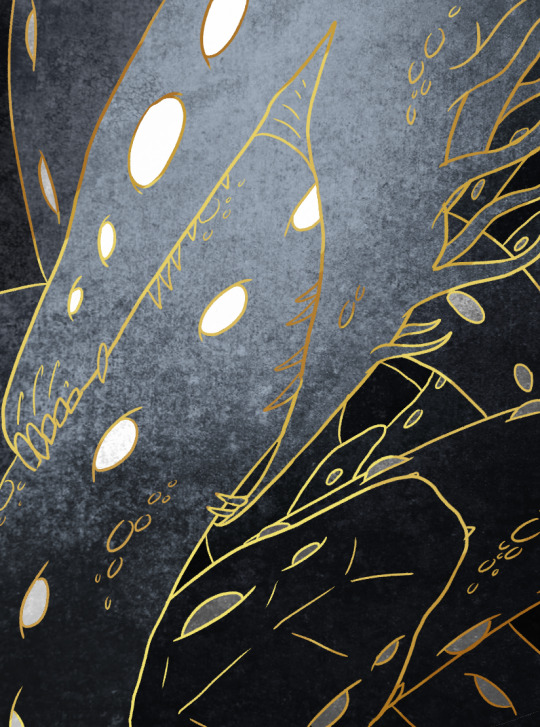
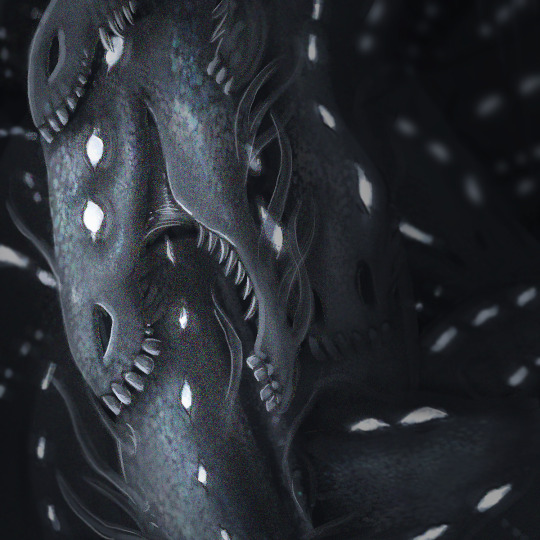
Artitengh is the Outsider God of Divine Magic and Inherent Power
A mysterious and elusive being, Artitengh is one of the oldest beings known to interact with Aanrah, often thought to be only younger than Kht’oth. It appears as a snake-like being that is continuously eating itself, covered in pale white eyes. Often viewed through a reflective surface or sometimes seen in the surface of the ocean, Artitengh exists in another layer of reality - one in which he takes up all space that is available to him. It is thought that if someone were o ever manage to summon him into Aanrah’s reality, Artitengh would expand to fill up all of this reality’s space, inevitebly destroying it in the process.
Only sought by those looking for power regardless of the cost and those looking to understand the realities beyond this one, Artitengh is known to be fully uncaring of the well being and safety of mortal beings, and only interested in doing what will entertain him the most. They thrive in the chaos caused by their actions, and really could care less what destruction and mayhem might befall the world.
It is said that those who touch Artitengh’s scales will unlock their inner power - but what that is is entirely unknown, even to Artitengh. As the god of inherent and divine power, Artitengh rules over the internal aspect native to all beings and things, which is what allows beings to conjure magic and preform otherwise extraordinary / supernatural feats without the use of actual spellcasting. For normal beings, however, this can ultimately become almost anything - the divine aspect of non-divine beings is rarely developed or honed enough to direct to any one source, as it might if they ascended to divinity. Instead, touching Artitengh is much akin to reaching into a bag of random superpowers that can range from perfect control over powerful aspects of reality to extremely niche case trigger powers that will randomly kill the user when they finally activate.
For this reason, Artitengh truly delights in letting anyone who works through the effort to reach him touch him. The chaos that results from whatever their power might be - useful or not - entertains Artitengh greatly.
He only speaks in Weg’olw’chyen, despite being able to understand and speak any language.
#eldritch#ouroboros#monster#homebrew#dnd#dungeons and dragons#tabletop#ttrpg#worldbuilding#deity#fantasy#god#oc#original character#Artitengh
23 notes
·
View notes
Photo

Not his ‘deity plaque’ kinda thing but. While I don’t know fully what I wanna do with my world, and don’t have a like... set story in mind for it, if I had to choose a character who’s the most ‘main’ character, it’s Bróbh Boíg. The bard god, Bróbh Boíg went from ‘haha party bard god I guess’ to ‘tragic man gets subjected to everything because everyone else decided his role in the world was to be Witness’.
Bróbh Boíg is more or less destined at this point to outlive everyone and everything else, and to sing the tales and history of what happened, as it happened. He’s been put in the difficult spot of being both one of the ‘hero’ gods and expected to uphold a certain moral standard or set of beliefs, while also being the one all the ‘villain’ gods go to and rely on to tell history as it really happened. He eternally walks a fine line with the hero gods for his habit it fraternizing with the enemy, but Bróbh Boíg genuinely wants to get every side of the story, so that the most truthful version will be what he sings, and what is remembered.
He’s metaphysically bound to the archfey god Ort through the fey equivalent of what is basically Forever Marriage, which is the symbol on the back of his left hand. His lute (and name) were gifts from Ort early on in their ‘relationship’.
While I have no idea what the fate of this world could be, I have largely decided that no matter what becomes of it, Bróbh Boíg will be there to see it, and will survive to leave with Ort to Nurí.
His name means “Wood Singer” in Náian. His birth name is Browai Dréómmalco, which can be translated in Náian to “Star Elkrun”
#elf#wood elf#homebrew#dnd#dungeons and dragons#original character#oc#bard#tabletop#ttrpg#fantasy#Brobh Boig#accents are not happening in these tags or I will find nothing ever
9 notes
·
View notes